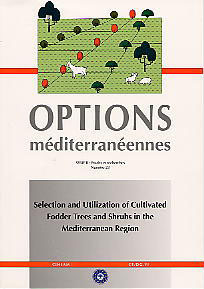| p. 1-93 |
Selection and utilization of cultivated fodder trees and shrubs in the Mediterranean Region
Cultivated fodder trees and shrubs can grow in dry and marginal areas of the Mediterranean region and provide invaluable feed to livestock during the long and dry summer period and mid-winter when herbaceous plants are dormant. The object of this project was to study the genetic potential of highly productive, mainly leguminous species, their adaptation and performance in different ecological environments and production systems, and the application of modern techniques for their establishment and grazing management. Seventeen species were tested in which a great variability in morphological, growth and nutritional characters was found. Productivity was found to be affected by the particular species or cultivar involved, the environmental conditions and the age of plants. It is concluded that fodder trees and shrubs are important strategic forage resources for stabilizing productivity and reducing the cost of livestock production systems in the Mediterranean region.
- [ Afficher ]
- [ Télécharger ]
- [ Exporter la citation ]
Vous pouvez télécharger la citation au format :
- [ Imprimer ]
-
Mots-clés
BIOMASSE, ETABLISSEMENT DE LA PLANTE, EVALUATION, MATERIEL GENETIQUE, PATURAGES, PLANTATIONS, PLANTE D'ABROUTISSEMENT, REGION MEDITERRANEENNE, RESISTANCE A LA TEMPERATURE, RESSOURCE GENETIQUE, SELECTION, VALEUR NUTRITIVECiter cet article
Papanastasis V.P., Tsiouvaras C.N., Dini-Papanastasi O., Vaitsis T., Stringi L., Cereti C.F., Dupraz C., Armand D., Meuret M., Olea L. Selection and utilization of cultivated fodder trees and shrubs in the Mediterranean Region. In : Papanastasis V.P. (comp.), Papanastasis V.P. (collab.). Selection and utilization of cultivated fodder trees and shrubs in the Mediterranean Region. Zaragoza : CIHEAM, 1999. p. 1-93. (Options Méditerranéennes : Série B. Etudes et Recherches; n. 23). http://om.ciheam.org/om/pdf/b23/99600126.pdf



